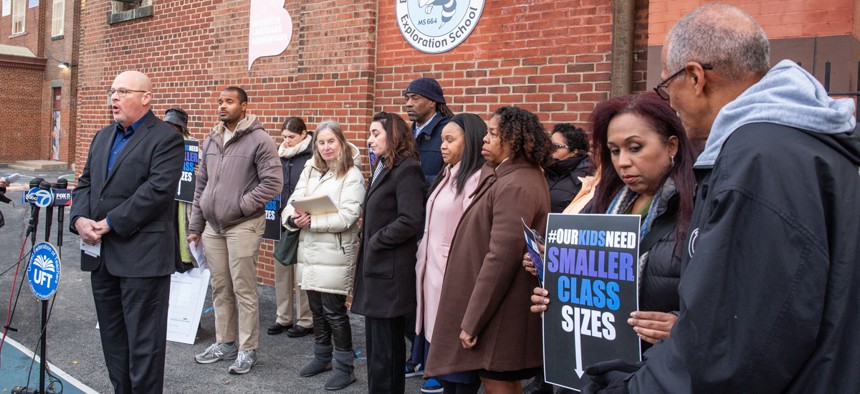Education
Report: More than 300K NYC students are in overcrowded classrooms
A UFT study found that 50% of schools with a high concentration of poverty that receive federal funds, have larger class sizes than state law currently limits.

United Federation of Teachers President Michael Mulgrew speaks at a press conference on the union’s latest report on overcrowding in classrooms outside a popular and overcrowded Title 1 school, Brooklyn Landmark Elementary School in Bed-Stuy, Brooklyn. Image by Erica Berger
More than 300,000 students in high-need schools are in overcrowded classrooms, according to a new analysis from the union representing the majority of New York City teachers.
Over the past year, Mayor Eric Adams and Department of Education leaders have expressed concerns about the city’s ability to meet the requirements of a new state law to incrementally lower class sizes in the latter part of its five year timeline. Some top education officials have also argued that the law will unintentionally sideline students with the greatest needs as many of the city’s overcrowded classrooms are concentrated in schools that attract wealthier families, meaning already popular schools would end up receiving more resources.
The United Federation of Teachers contends that’s not the case. According to the union’s analysis, at least 50% of 665 Title 1 schools – schools with a high concentration of poverty that receive federal funds – have larger class sizes than the state law currently limits. In 40 of those schools, every single classroom is over the limit. And overall, 97% of the city’s roughly 1,267 Title 1 schools have at least one oversized classroom, according to the analysis.
The state law, passed by lawmakers last year, caps kindergarten through third grade classes at 20 students. Grades 4-8 are capped at 23 students and high school classes top out at 25 students. An additional 20% of New York City classrooms are required to comply with the law’s cap every year, starting this fall until 2028 when all would be expected to reach compliance.
“I don’t know any other way to say it. It’s just wrong,” UFT President Michael Mulgrew said Tuesday morning. “The neediest children of our city deserve what the rest of the children in this state already have. That’s why we fought for this law. That’s why we know this law is the right thing to do. We knew we had to go to Albany to make a law specifically for New York City because New York City never had any intention of giving their children the same equity of what the children in the rest of the state already had.”
The UFT unveiled the data at a Tuesday press conference at Brooklyn Landmark Elementary School alongside advocates, educators and a handful of elected officials, including state Sens. Robert Jackson and Jabari Brisport, Rep. Latrice Walker and City Council Members Rita Joseph and Sandy Nurse.
The education department recently did its own analysis on class sizes and found that 40% of its classrooms are under the newly mandated caps – more than what is required at this early stage of implementation. According to the department’s findings, 62% of classes in the highest need schools are currently under the caps compared to 25% of the most affluent schools. The UFT’s report analyzed the data differently than the education department, which compared schools within the system to each other instead of looking at the number of Title 1 schools.
“It is very clear and has been demonstrated by multiple independent analyses that the districts with the most classes over the caps are in the city's most affluent communities, which takes resources out of schools with the highest needs,” Nicole Brownstein, a spokesperson for the department, said in a statement. “We continue to call upon our partners in state and federal government to support us with additional funding,”
But supporters of the class size law worry that trends are going in the wrong direction. The education department celebrated the system’s first enrollment increase in the last eight years last week – a big win for a system that hemorrhaged students in wake of the COVID-19 pandemic. Still, the increase complicates the city’s ability to meet the caps as average class sizes increased in all grade levels compared to last school year, according to Leonie Haimson, executive director of the group Class Size Matters.
“The number of schools that meet the caps has gone down drastically and we will not make the 40% requirement in the law next year if the current trends continue,” she said.
New York City’s new class size restrictions have long been the focal point of a fierce debate. The UFT and other supporters have accused city officials of dragging their feet on the planning process that they say is key to being able to lower class sizes. Adams and New York City schools Chancellor David Banks have attested that while they support the sentiment of lower class sizes, the measure will cost the city hundreds of millions of additional dollars to hire more teachers and add more classrooms to meet requirements. They’ve warned that some schools may have to make difficult budgetary decisions in the latter part of the law’s five-year timeline as more classes need to meet the requirements.
State lawmakers and other supporters adamantly disagree with claims that the mandate is unfunded. They say that the Legislature sent $1.6 billion in additional Foundation Aid to help New York City classrooms meet the caps.
“I’m tired of seeing this mayoral administration undermine the work we do. We sent more money to New York City for education just to see this administration fight to cut schools over and over and over again.” Brisport, a former teacher, said. “We passed the class size bill just to see data showing that class sizes are now increasing.”

NEXT STORY: Hochul announces attempt to address hate online amid rise in antisemitism and Islamophobia
